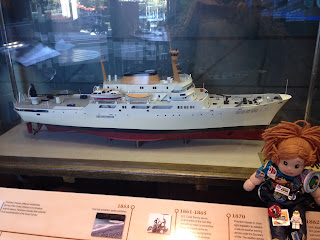HI Sea Fans!
I had the privilege of visiting the NOAA Gateway, an interactive exhibition about NOAA's science.
 |
| "Hand of NOAA" by Ray Kaskey – this sculpture of a giant hand releasing seagulls to the ocean represents the agency’s mission of recording and protecting the environment. |
The Survey of the Coast was formed in 1807, renamed a few times and then became a part of NOAA in 1970.
Some items from early Coast Survey
ships included china, a hat and epaulets from uniforms.
The Survey's mission was to provide accurate nautical charts (maps of the oceans), but now it includes most of the physical sciences including:
·
hydrography (the science of the
measurement and description and mapping of the surface waters of the earth with
special reference to navigation),
·
geodesy (the branch of maths dealing
with the shape and area of the earth or large portions of it),
·
astronomy (the study of celestial
objects, space, and the physical universe as a whole),
·
topography (detailed mapping or
charting of the features of a relatively small area),
·
oceanography (the study of the physical
and biological properties and phenomena of the sea.),
·
tide and current measurement and
prediction,
·
seismology (the study of earthquakes
and related phenomena),
·
magnetics,
·
national standards,
·
photogrammetry (the use of photography
in surveying and mapping to figure out measurements between objects.),
·
and more.
I loved my visit, but I really enjoyed the videos from Ocean
Today (http://oceantoday.noaa.gov/) and the Turtle Excluder Device (TED) which is a specialized device that
allows a captured sea turtle to escape when caught in a
fisherman's net.
In particular, sea turtles can be caught when
bottom trawling is used by the commercial shrimp fishing industry. In order to
catch shrimp, a fine meshed trawl net is needed.
 |
| Here are my new friends, Bruce, Molly and Peg in front of the new Science on Sphere (http://sos.noaa.gov/What_is_SOS/index.html) |
Thanks so much to Peg Steffen for showing me around!
Have a great week, Sea Fans!
Cheers
Abby
}( *)8























